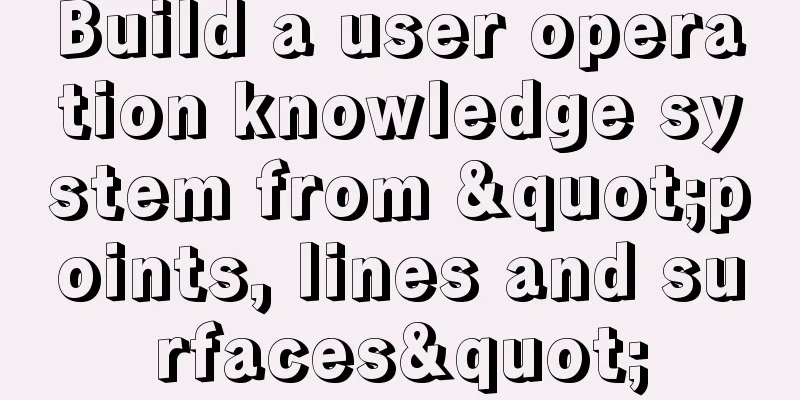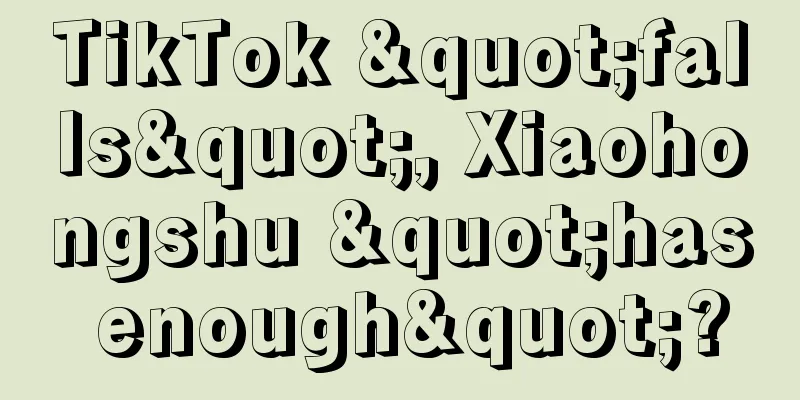Build a user operation knowledge system from "points, lines and surfaces"

1. “Operation is not about survival, but about growth”Before building a knowledge system, let me first put forward a "growth" point of view: all operations should do things with a growth mindset. If operations only do some daily maintenance work, send WeChat groups, public accounts, and PUSH notifications, they are likely to be eliminated in the current job market. Because college students who make 150 yuan a day can make a lot of money. Therefore, the purpose of writing this article is also to hope that new operators will have a growth mindset when building their own knowledge system, whether it is personal growth or company business growth. Because most of my past experience was in dealing with users and products, the following content will be shared more from the perspective of "user operation", which I am more familiar with. I also hope to be able to use some points to illustrate the whole and better trigger everyone's thinking. 2. Opinion FirstNew operators should learn how to build their own knowledge system. 1. Start with fragmented knowledge and learn to update your own learning knowledge baseYou can record your own "learning fragments" through mind maps, online documents, etc. There is no need for a variety of tools in the early stage, as long as the basic function of recording is enough. The important thing is to record and update at all times. 2. Understand the business indicators associated with an operation plan and try to connect them like points, lines, surfaces and volumes.Don't just work hard on execution and do the dirty work. You need to know the business indicators behind it and then organize your answer to this question. 3. Keep updating and growingYou should eliminate others, but don't let others eliminate you. It doesn't mean you should crush others, but you should use your brain and the mindset of self-growth to do things. 3. What do you think is operation?Many operations experts have shared answers to this question, and the answers they shared are similar. My summary is "linking users and products without human intervention." Let’s think more deeply about why we need to make this link; fundamentally, it is to gain more users and make more money. Looking at the methods, the "how to do it" becomes the daily work content of operations. Of course, everyone has a different understanding of operations at each stage, and everyone is welcome to think about and share different ideas. 4. How will you operate after joining the company?There are 4 types of knowledge structures mentioned in the book "User Growth Methodology". I have deeply experienced them in my past work and agree with them. Therefore, the following content will start from this perspective and try to provide you with ideas for systematically building an operational knowledge system from the perspective of "point-line-surface". 1. Lay a solid foundation of “point-like knowledge”Many friends will definitely encounter this question during the interview process: how to operate an account, a product or a group of users after joining the company? Let's make this question more specific. Let's take user growth as an example: With the existing resources, you need to recruit 1,000 new users for your food delivery app by the end of the month. How would you accomplish this? (Just follow your own ideas, no need to pile up professional terms) Your answer might be: First, check how many users the app has, then check the available resources, and decide which channels to use to attract new users. You may ask some food bloggers to promote it, or you may sell milk tea offline, or you may do a push to wake up some old users. But after a week, only 20 users are left. At this time, you need to consider how to keep them. This series of questions and things that come to mind are operations. Do you say you don’t understand operations? Do you also know about attracting new customers and retaining customers? What you lack is the professional knowledge behind these plain words. You need to know the indicators associated with an operation action, and then understand what these indicators mean to lay a solid foundation. Take the classic pirate ship model of "AARRR" as an example: Each of these indicators, DAU, LTV, and GMV, is related to daily operations. New operators can break down these basic terms through some models or daily work. For example, start with the AARRR model, break down and learn these fragmented indicators, know what DAU means, and accumulate their own operational expertise first. During the learning process, remember to develop the habit of recording and organizing, so that you can update your own learning library from time to time. 2. Connect to "Linear Knowledge" through Daily PlansWhat is "linear knowledge"? It is like when you ask a Wuhan native what delicious food there is in Wuhan, then he or she will have a point-to-point "linear knowledge" relationship with hot dry noodles. After learning about point-like knowledge fragments such as "attracting new users, retention rate, DAU", new operations personnel should also have some understanding of the current operations work at hand. Maybe when you are faced with the question “How do we acquire new users with the target profile?”, there will be a certain answer. For example: using channels such as Xiaohongshu and Douyin to publish official content to attract traffic, or finding some influencers to invest in content, or asking users to invite new… In this way, a linear logical relationship is formed between "channel" knowledge and "new users". 3. Use global thinking to construct surface "structural knowledge"After becoming familiar with a business line, try to construct some "structural knowledge" in this form. For example, if the loss of new users of a product is serious recently, how can we improve the retention rate of new users? We can think from many aspects such as product, operation, brand, channel, etc., and each aspect can be subdivided. From an operational perspective, we can find out why users retain or churn through activities, channel quality, retained user analysis, etc., and optimize the retention rate. From a product perspective, you can think about whether users are following a given process to optimize their retention of the product based on the product's functions and user life cycle. From a brand perspective, you can use event marketing, advertising, social media, and other methods to promote the product and increase user awareness of the product. When we can provide a systematic optimization solution to problems such as "low retention rate" and "low daily active users", our operational knowledge structure is actually established. In our daily work and life, we need more solutions and cases to improve our knowledge structure. 5. “Growth Mindset” after Laying a Solid FoundationIn my second job, I joined a local life startup as an operator. Since I was the No. 001 employee of a startup after the epidemic, I also did a lot of work, including platform customer service, media execution, product operation, recruitment, etc. At that time, I didn’t have any growth thinking, just keeping this APP alive. It was not until I experienced rounds of "firing and being fired" that I gradually realized that all operations should do things with a "growth" mindset. It is actually very simple to cultivate this mindset. Put yourself in the boss's shoes and think about what value you bring to the company or what more value you can create. At this time, you will have a clearer idea of where you can achieve more growth in this position. To put it bluntly, the only way to survive in this market environment is to keep yourself updated, keep evolving, and use your brain to do things. Author: lajutt |
<<: Short videos are getting longer and longer, and Douyin is "abandoning" short videos
Recommend
Do I need to pay a deposit after joining Shopee? What are the fees?
Shopee may not be familiar to those who are not en...
More convenient! Taobao will fully support WeChat payment!
For a long time, due to commercial competition and...
Why has offline store design become a battleground for brand marketing?
Have you taken a citywalk today? As this simple an...
How to save yourself when someone copies your product on Amazon? What are the methods?
When opening a store on Amazon, you may encounter ...
Our Xiaohongshu operation is resigning and starting a business
Nowadays, more and more people choose to join Xiao...
How to operate a teaching and training community from 0 to 1 - Methodology
Building a community system is crucial to the succ...
How to register and open a store on Amazon? What should I pay attention to on Amazon?
Now there are many merchants who want to start a b...
How does Amazon charge for advertising? What are the tips?
In addition to on-site and off-site advertising, A...
How to conduct a large-scale sales meeting?
It's the end of the year, and there is still s...
Apple WWDC24: C-side focuses on AI, B-side enters advertising measurement
Apple announced various updates to iOS 18 at WWDC2...
For large companies, your competitive advantage lies in this...
This article mainly talks about how small and medi...
How often are Amazon's replenishment limits updated? How to deal with Amazon's replenishment restrictions?
When opening a store on Amazon, merchants may be r...
How to open a cross-border e-commerce store at home? How to do it at home?
Cross-border e-commerce is aimed at the global mar...
How to file a complaint against follow-up sales on Amazon? What is the method?
In the process of opening a store on Amazon, there...
How can I register on Shopee? How can I register?
There are more and more stores on the Shopee platf...









